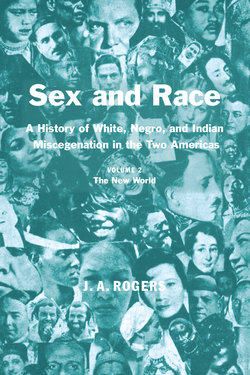Sex and Race, Volume 2

Реклама. ООО «ЛитРес», ИНН: 7719571260.
Оглавление
J. A. Rogers. Sex and Race, Volume 2
SEX AND RACE
CONTENTS
Chapter One
Chapter Two
Chapter Three
Chapter Four
Chapter Five
Chapter Six
Chapter Seven
Chapter Eight
Chapter Nine
Chapter Ten
Chapter Eleven
Chapter Twelve
Chapter Thirteen
Chapter Fourteen
Chapter Fifteen
Chapter Sixteen
Chapter Seventeen
Chapter Eighteen
Chapter Nineteen
Chapter Twenty
Chapter Twenty-one
Supplement to Chapter Twenty-one
Chapter Twenty-two
Chapter Twenty-three
Chapter Twenty-four
Chapter Twenty-five
Chapter Twenty-six
Chapter Twenty-seven
Chapter Twenty-eight
Chapter Twenty-nine
Chapter Thirty
Chapter Thirty-one
Chapter Thirty-two
Chapter Thirty-three
Chapter Thirty-four
Chapter Thirty-five
Chapter Thirty-six
Chapter Thirty-seven
Chapter Thirty-eight
Отрывок из книги
LATIN AMERICA’S MOST ILLUSTRIOUS FIGURE.
I. Simon Bolivar, Liberator of five South American Countries and one of the most colossal figures of history.
.....
Among other eminent Brazilians with a Negro strain were John VI, King of Portugal60 and Brazil, who left Portugal during the Napoleonic Wars and established his royal seat at Rio de Janeiro. John VI was about five-eighths Negro; his son, Pedro I of Brazil, founder of Brazilian Independence, and brother-in-law of Napoleon, was consequently of Negro ancestry, also. This, in turn gave a Negro strain, though attenuated to the latter’s son, Dom Pedro II, one of the handsomest, most intellectual, and most enlightened rulers in all history. Carlos Gomes, the first man of the New World to write an opera that received highest European recognition, was of mixed Negro. Caucasian, and Indian ancestry. Pradez, writing in 1872, when Gomes was still alive, said, “The first extraordinary musician that Brazil ever produced is found to be a colored man.”61 Gomes was sent to Europe to study at Dom Pedro II’s expense. Antonio C. G. Crespo (1846-1883), mulatto, born in Brazil, was one of Portugal’s most celebrated writers. He married Maria Amalia de Carvalho, white, also a celebrated writer. Another very noted mulatto was Jose de Patrocinio, son of a Portuguese-Indian priest and a Negro women. Patrocinio, who was known as “The Abolition Tiger” led the fight for the emancipation of the slaves through his brilliant and biting articles in La Gazeta de la Tarde. Machado de Assis, another mulatto, was for a long time Brazil’s most eminent literary figure. Nilo de Pecanha (1867-1922), another mulatto, was president of Brazil, while General Deodoro de Fonseca, usually called Deodoro, the founder of the Brazilian republic and its first president was colored.62 Brazil has had not less than five colored presidents.
As for the distinguished colored men of Brazil—writers, engineers, scientists, statesmen, soldiers, journalists, merchants and others—the list is too great to be given here. Arthur Ramos has a partial list of them.63 One of the greatest of all the Brazilian poets was Joao Cruz e Sousa (1862-1898), son of a Negro slave. There was at least one Catholic archbishop, too, Silverio Pimenta.
.....